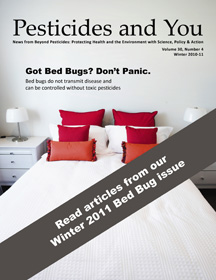Bed Bugs: Don’t Panic
Bed Bugs:
(1) Do Not Transmit Disease and
(2) Can Be Controlled without Toxic Pesticides
 Bed Bug Factsheet (January 2011)
Bed Bug Factsheet (January 2011)- Bed Bug Pesticides and You Articles (January 2011)
- Press Release (September 2010)
The bed bug resurgence across the U.S. has homeowners and apartment dwellers taking desperate measures to eradicate these tenacious bloodsuckers, with some relying on dangerous pesticides and fly-by-night exterminators. Even pesticides registered by the U.S. Environmental Protection Agency (EPA) for bed bug use are linked to acute poisoning, cancer, hormone disruption, asthma, neurotoxicity, organ damage, and more. Use of these measures poses more dangers than any perceived short-term benefit.
Although there is no "magic bullet" for eradicating bed bugs, there are many ways to control them effectively without using dangerous chemical pesticides. A national solution to the bed bug problem will require a comprehensive public health campaign, including public service announcements, travel tips, and perhaps even government-sponsored, integrated pest management programs for public housing and other high-density areas. At home bed bugs can be effectively controlled through monitoring, sanitation, sealing, heat treatments, and other protocols.
Below are steps to take to reduce and eliminate bed bug populations in the home:
- Caulk and seal crevices. Prevent bed bugs from entering your home.
- Eliminate clutter. Getting rid of as much clutter as possible will help you locate and eliminate infestations.
- Vacuum. This will remove only visible bed bugs, but is important to get rid of dead bed bugs and their frass. Use a stiff brush to dislodge eggs in cracks and crevices, and use a vacuum attachment (without bristles) to get into the corners. Be sure to discard the bag immediately after vacuuming.
- Launder fabrics and clothing. Wash and dry clothing for 30 minutes (or a full cycle) at the hottest setting the fabric will allow. "Dry clean only" clothes can simply be put into the dryer. If the fabric is too delicate for the hottest temperature, place it on a lower heat setting and let it run for the full cycle.
- Encase mattresses and box springs. Make sure the encasement is sturdy (i.e., will not easily tear), has been tested for bed bugs, and does not contain synthetic pesticides impregnated in the material. All bed bugs inside the encasement will eventually be killed.
- Steam treatment. Steam treatment will kill all stages of bedbugs. Move the nozzle over the bed bugs at a rate of 20 seconds per linear foot; wrap a piece of fabric over the nozzle to reduce water pressure so bed bugs aren't blown away by the force. Many pest control companies provide this option, but you may have to ask for it.
- Heat treatment. Heat — either ambient or blown with a fan, can provide complete control of bed bugs if all areas of infestation reach 120° F.
Regulatory Update
In November 2009, the Ohio Department of Agriculture asked EPA to allow an unregistered use of the neurotoxic and cancer causing insecticide propoxur in homes to fight bedbugs in what state officials are describing as an ‘emergency’ situation. In December 2009, Beyond Pesticides sent comments to EPA urging the agency to deny the request because safer alternatives exist and its use would put children in danger. Under pressure from Beyond Pesticides and others, EPA refused Ohio’s request for an emergency exemption (read more).
For more information on least toxic control of other pests go to our ManageSafe page or call Beyond Pesticides at 1.202.543.5450.








